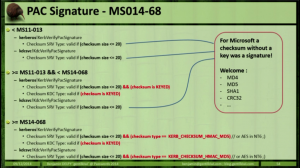MS14-068 References: AD Kerberos Privilege Elevation Vulnerability: The Issue Detailed Explanation of MS14-068 MS14-068 Exploit POC with the Python Kerberos Exploitation Kit (aka PyKEK) Exploiting MS14-068 Vulnerable Domain Controllers Successfully with the Python Kerberos Exploitation Kit (PyKEK) PyKEK Kerberos Packets on the Wire aka How the MS14-068 Exploit Works The folks at BeyondTrust have …
Tag: ActiveDirectory
Nov 18 2014
MS14-068: Vulnerability in (Active Directory) Kerberos Could Allow Elevation of Privilege
Active Directory leverages the Kerberos protocol for authentication. The vulnerability patches an issue with how the Domain Controller validates group membership in Kerberos tickets (hint: the ticket is always validated by the DC if the checksum is set to certain values). Microsoft KB3011780 patches this issue. According to Microsoft: “When this security bulletin was issued, …
Nov 17 2014
PowerShell: Discover Active Directory Forest Domain Controllers
Recently I needed to find all Domain Controllers in a large Active Directory forest (and see the AD Domain Functional Level for each domain). Here’s the PowerShell code which leverages the Active Directory PowerShell module cmdlets. import-module ActiveDirectory $ADForestInfo = Get-ADForest $ADForestInfoName = $ADForestInfo.Name $ADForestInfoDomains = $ADForestInfo.Domains $ADForestInfoForestMode = $ADForestInfo.ForestMode $AllDCs = $Null ForEach …
Nov 15 2014
Active Directory Replication Overview & USN Rollback: What It Is & How It Happens
If you have experienced event id #2095, then you understand how a USN Rollback can negatively affect AD consistency. What is a USN? The USN (Update Sequence Number) is an Active Directory database instance counter that increments every time a single change is committed to the AD database on a Domain Controller. The USN is …
Nov 10 2014
Kerberos & KRBTGT: Active Directory’s Domain Kerberos Service Account
Every Domain Controller in an Active Directory domain runs a KDC (Kerberos Distribution Center) service which handles all Kerberos ticket requests. AD uses the KRBTGT account in the AD domain for Kerberos tickets. The KRBTGT account is one that has been lurking in your Active Directory environment since it was first stood up. Each Active …
Nov 02 2014
Domain Controller Virtual Cloning
One of the best new features of Windows Server 2012 is virtual cloning. The ASKPFE blog has an excellent article covering this new feature: Tom Moser here with a post on one of the new ADDS features in Windows Server 2012; Virtual Domain Controller Cloning. Until now, cloning, snapshotting, copying, or pretty much doing anything …
Nov 01 2014
Active Directory Domain Trusts & Trust Password Management
Recently a customer asked me about Active Directory Domain Trusts and how the passwords were managed. I replied with some educated guesses based on how AD manages a variety of passwords. After stating how I thought it worked (and mentioned that I wasn’t sure), I decided to look it up. I was mostly correct. Every …
Oct 29 2014
Windows Server 2012 R2 deprecates FRS (File Replication Service)
Microsoft’s Tip of the Day has the following useful information on Domain Controller File Replication Service (FRS) depercation: FRS (File Replication Service) has been deprecated in Windows Server 2012 R2. The deprecation of FRS has been accomplished by enforcing a minimum domain functional level of Windows Server 2008. This enforcement is present only if the …



Recent Comments